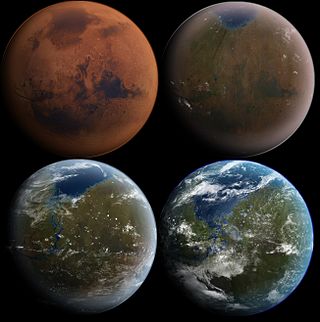
Crewmembers setting up weather monitoring equipment on the surface of Mars (artist's concept).
A
human mission to Mars has been the subject of
science fiction,
engineering, and scientific proposals throughout the 20th century and into the 21st century. The plans comprise proposals to land on
Mars, eventually
settling on and
terraforming the planet, while exploiting its moons,
Phobos and
Deimos.
Exploration of Mars has been a goal of national space programs for decades. Preliminary work for missions that would involve human explorers has been undertaken since the 1950s, with planned missions typically being cited as taking place 10 to 30 years in the future when they are drafted. The
list of manned Mars mission plans in the 20th century shows the various mission proposals that have been put forth by multiple organizations and
space agencies in this field of
space exploration.
In terms of the current U.S. space program,
NASA's long-term program
Orion has a projected pace of development such that, as of late 2014, human spaceflight to Mars is anticipated in about 2035. That mission will be preceded by shorter flights for the up to four-person capsule involved, with experiments taking place to better the technologies protecting Mars-bound astronauts from the radiation of deep space.
[1]
In fiction, the concept of humans traveling to and
terraforming Mars has been explored in books, graphic novels, and films. Examples include:
Kim Stanley Robinson's
Mars trilogy,
Total Recall,
Red Planet, and
Ghosts of Mars. The appeal of space-travel to the planet is a major aspect to
Mars in fiction.
Travel to Mars

Closest approaches of Mars to Earth, 2014-2061. Communication times are slightly shorter when it is closest.
In
interplanetary travel the energy needed for transfer between planetary orbits is lowest at intervals fixed by the
synodic period. For Earth / Mars trips, this is every 26 months (2 years and 2 months),
[2] so missions are typically planned to coincide with one of these
launch windows. The energy needed in the low-energy windows varies on roughly a 15-year cycle
[2] with the easiest windows needing only half the energy of the peaks.
[3] In the 20th century, there was a minimum in the 1969 and 1971 launch windows and another low in 1986 and 1988, then the cycle repeated.
[2]
Several types of mission plans have been proposed, such as the opposition class and conjunction class,
[3] or the
Crocco flyby.
[4] However, typical Mars mission plans have round-trip flight times of 400 to 450 days.
[5] A fast Mars mission of 245 days round trip could be possible with on-orbit staging.
[6] Using
Hohmann transfer orbits is a common plan. In 2014
Ballistic capture was proposed, which may reduce fuel cost and provide more flexible launch windows compared to the Hohmann.
[7]
Challenges

Comparison of radiation doses - includes the amount detected on the trip from Earth to Mars by the
RAD inside the
MSL (2011 - 2013).
[8][9][10] The vertical axis is in
logarithmic scale. The dose over a Mars year is about 15 times the DOE limit, not less than twice, as a quick glance might suggest.
There are several key challenges for human missions to Mars:
- Costs of sending people to Mars. Estimates have ranged from $6 billion to $500 billion for crewed programs.[11][12][13]
- Health threats from exposure to high-energy cosmic rays and other ionizing radiation.[14][15][16] On 31 May 2013, NASA scientists reported that a possible manned mission to Mars may involve a great radiation risk based on the amount of energetic particle radiation detected by the RAD on the Mars Science Laboratory while traveling from the Earth to Mars in 2011-2012. The calculated radiation dose was 0.66 sieverts round-trip. The agency's career radiation limit for astronauts is 1 sievert.[8][9][10][17]
- Negative effects of a prolonged low-gravity environment on human health, including eyesight loss.[18][19][20]
- Psychological effects of isolation from Earth and, by extension, the lack of community due to impossibility of real-time connections with Earth.
- Social effects of several humans living under crowded conditions for more than one Earth year, possibly two or three years, on the mission to Mars, and a comparable length of time on the return to Earth.
- Inaccessibility of terrestrial medical facilities.
- Equipment failure of propulsion or life-support systems.
- Forward contamination of potential habitable zones.[21]
- Back contamination of Earth with possible Martian microbes.
Some of these issues were estimated statistically in the HUMEX study.
[22] Ehlmann and others have reviewed political and economic concerns, as well as technological and biological feasibility aspects.
[23] While fuel for roundtrip travel could be a challenge, methane and oxygen can be produced using Martian H
2O (preferably as water ice instead of liquid water) and atmospheric CO
2 with mature technology.
[24]
Mission proposals
20th century
Over the last century, a number of mission concepts for such an expedition have been proposed. David Portree's history volume
Humans to Mars: Fifty Years of Mission Planning, 1950 - 2000 discusses many of these.
[2]
Wernher von Braun proposal (1947 through 1950s)
Wernher von Braun was the first person to make a detailed technical study of a Mars mission.
[2][25] Details were published in his book
Das Marsprojekt (1952); published in English as
The Mars Project[26] (1962) and several subsequent works,
[27] and featured in
Collier's magazine in a series of articles beginning March 1952. A variant of the Von Braun mission concept was popularized in English by
Willy Ley in the book
The Conquest of Space (1949), featuring illustrations by
Chesley Bonestell. Von Braun's Mars project envisioned nearly a thousand three-stage vehicles launching from Earth to ferry parts for the Mars mission to be constructed at a space station in Earth orbit.
[25][28] The mission itself featured a fleet of ten spacecraft with a combined crew of 70 heading to Mars, bringing three winged surface excursion ships that would land horizontally on the surface of Mars. (Winged landing was considered possible because at the time of his proposal, the Martian atmosphere was believed to be much denser than was later found to be the case.)
In the 1956 revised vision of the Mars Project plan, published in the book
The Exploration of Mars by Wernher Von Braun and Willy Ley, the size of the mission was trimmed, requiring only 400 launches to put together two ships, still carrying a winged landing vehicle.
[29] Later versions of the mission proposal, featured in the
Disney "Man In Space" film series,
[30] showed
nuclear-powered ion-propulsion vehicles for the interplanetary cruise.
U.S. proposals (1950s and 1960s)
In 1962, Aeronutronic Ford,
[31] General Dynamics and the Lockheed Missiles and Space Company made studies of Mars mission designs as part of NASA Marshall Spaceflight Center "
Project EMPIRE".
[25] These studies indicated that a Mars mission (possibly including a Venus fly-by) could be done with a launch of eight Saturn V boosters and assembly in low Earth orbit, or possibly with a single launch of a hypothetical "post Saturn" heavy-lift vehicle. Although the EMPIRE missions were only studies, and never proposed as funded projects, these were the first detailed analyses of what it would take to accomplish a human voyage to Mars using data from the actual NASA spaceflight, and laid much of the basis for future studies, including significant mission studies by TRW, North American, Philco, Lockheed, Douglas, and General Dynamics, along with several in-house NASA studies.
[25]
Following the success of the
Apollo Program, von Braun advocated a manned mission to Mars as a focus for NASA's manned space program.
[32] Von Braun's proposal used
Saturn V boosters to launch nuclear-powered (
NERVA) upper stages that would power two six-crew spacecraft on a dual mission in the early 1980s. The proposal was considered by (then president)
Richard Nixon but passed over in favor of the
Space Shuttle.
Soviet mission proposals (1956 through 1970)
The
Martian Piloted Complex or "'MPK'" was a proposal by
Mikhail Tikhonravov of the Soviet Union for a manned Mars expedition, using the (then proposed) N-1 rocket, in studies from 1956 to 1962.
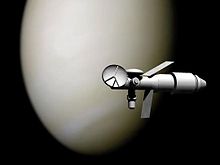
Artist's depiction of TMK-MAVR
Heavy Interplanetary Spacecraft (known by the Russian acronym
TMK) was the designation of a Soviet Union space exploration proposal in the 1960s to send a manned flight to Mars and Venus (TMK-MAVR design) without landing. The TMK spacecraft was due to launch in 1971 and make a three-year-long flight including a Mars fly-by at which time probes would have been dropped. The TMK project was planned as an answer from the Soviet Union to the United States manned moon landings. The project was never completed because the required
N1 rocket never flew successfully.
The
Mars Expeditionary Complex, or "'MEK"' (1969) was another Soviet proposal for a Mars expedition that would take a crew from three to six to Mars and back with a total mission duration of 630 days.
Case for Mars (1981–1996)
Following the
Viking missions to Mars, between 1981 and 1996 a series of conferences named The Case for Mars were held at the
University of Colorado at Boulder. These conferences advocated human exploration of Mars, presented concepts and technologies, and held a series of workshops to develop a baseline concept for the mission.
The baseline concept was notable in that it proposed use of
In Situ Resource Utilization to manufacture rocket propellant for the return trip using the resources of Mars. The mission study was published in a series of proceedings volumes
[33][34] published by the
American Astronautical Society. Later conferences in the series presented a number of alternative concepts, including the "Mars Direct" concept of
Robert Zubrin and David Baker; the "Footsteps to Mars" proposal of
Geoffrey A. Landis, which proposed intermediate steps before the landing on Mars, including human missions to Phobos; and the "Great Exploration" proposal from
Lawrence Livermore National Laboratory, among others.
NASA Space Exploration Initiative (1989)
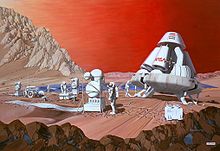
Artist's conception of a human mission on the surface of Mars
1989 painting by Les Bossinas of
Lewis Research Center for NASA
In response to a presidential initiative, NASA made a study of a project for human lunar- and Mars exploration as a proposed follow-on to the
International Space Station project. This resulted in a report, called the
90-day study,
[36] in which the agency proposed a long-term plan consisting of completing the Space Station as "a critical next step in all our space endeavors," returning to the moon and establishing a permanent base, and then sending astronauts to Mars. This report was widely criticized as too elaborate and expensive, and all funding for human exploration beyond Earth orbit was canceled by Congress.
[37]
Mars Direct (early 1990s)
Because of the distance between Mars and Earth, the Mars mission would be much more risky and more expensive than past manned flights to the Moon. Supplies and fuel would have to be prepared for a 2-3 year round trip and the spacecraft would have to be designed with at least partial shielding from intense solar radiation. A 1990 paper by
Robert Zubrin and David A. Baker, then of
Martin Marietta, proposed reducing the mission mass (and hence the cost) with a mission design using
in situ resource utilization to manufacture propellant from the Martian Atmosphere.
[38][39] This proposal drew on a number of concepts developed by the former "
Case for Mars" conference series. Over the next decade, this proposal was developed by Zubrin into a mission concept,
Mars Direct, which he developed in a book,
The Case for Mars (1996). The mission is advocated by the
Mars Society, which Zubrin founded in 1998, as a practical and affordable plan for a manned Mars mission.
International Space University (1991)
In 1991 in Toulouse, France, the International Space University studied an international human Mars mission.
[40] They proposed a crew of 8 traveling to Mars in a nuclear-powered vessel with artificial gravity provided by rotation.
[40] On the surface, 40 tonne habitats pressurized to 10 psi were powered by a 40 kW photovoltaic array.
[40]
NASA Design reference missions (1990s)
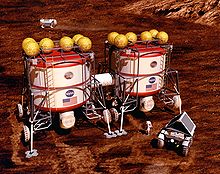
NASA Mars habitat concept for DRA 1.0, derived from the Mars Direct Architecture. (1995)
In the 1990s NASA developed several conceptual level human Mars exploration architectures. One of these was NASA
Design reference mission 3.0 (DRM 3.0). It was a study performed by the NASA Mars Exploration Team at the NASA's Johnson Space Center (JSC) in the 1990s. Personnel representing several NASA field centers formulated a "Reference Mission" addressing human exploration of Mars. The plan describes a human mission to Mars with concepts of operations and technologies to be used as a first cut at an architecture. The architecture for the Mars Reference Mission builds on previous work, principally on the work of the Synthesis Group (1991) and Zubrin's (1991) concepts for the use of propellants derived from the Martian atmosphere. The primary purpose of the Reference Mission was to stimulate further thought and development of alternative approaches, which can improve effectiveness, reduce risks, and reduce cost. Improvements can be made at several levels; for example, in the architectural, mission, and system levels.
Selected other US/NASA plans (1988–2009):
[41]
- 1) 1988 "Mars Expedition"
- 2) 1989 "Mars Evolution"
- 3) 1990 "90-Day Study"
- 4) 1991 "Synthesis Group"
- 5) 1995 "DRM 1"
- 6) 1997 "DRM 3"
- 7) 1998 "DRM 4"
- 8) 1999 "Dual Landers"
21st Century
NASA Design reference missions (2000+)

Concept for NASA Design Reference Mission Architecture 5.0 (2009)
Development of reference missions continued in the 21st century Selected other US/NASA plans (1988–2009):
[41]
- 11) 2000 SERT (SSP)
- 12) 2002 NEP Art. Gravity
- 13) 2001 DPT/NEXT
- 14) 2009 DRA 5
MARPOST (2000/2005)
The
Mars Piloted Orbital Station (or MARPOST) is a
Russian proposed manned orbital mission to
Mars, using a
nuclear reactor to run an electric rocket engine. Proposed in October 2000 by Yuri Karash from the Russian Academy of Cosmonautics as the next step for Russia in space along with the Russian participation in the
International Space Station, a 30-volume draft project for MARPOST has been confirmed as of 2005.
[42] Design for the ship proposed to be ready in 2012, and the ship itself in 2021.
[43]
ESA Aurora programme (2001+)
The
European Space Agency had a long-term vision of sending a human mission to Mars in 2033.
[44] Laid out in 2001, the project's proposed timeline would begin with robotic exploration, a
proof of concept simulation of sustaining humans on Mars, and eventually a manned mission; however, objections from the participating nations of ESA and other delays have put the timeline into question.
ESA/Russia plan (2002)
Another proposal for a joint ESA mission with Russia is based on two spacecraft being sent to Mars, one carrying a six-person crew and the other the expedition's supplies. The mission would take about 440 days to complete with three astronauts visiting the surface of the planet for a period of two months. The entire project would cost $20 billion and Russia would contribute 30% of these funds.
[45]
USA Vision for Space Exploration (2004)
 Project Constellation
Project Constellation included an
Orion Mars Mission. United States President
George W. Bush announced an initiative of manned space exploration on January 14, 2004, known as the
Vision for Space Exploration. It included developing preliminary plans for a lunar outpost by 2012
[46] and establishing an outpost by 2020. Precursor missions that would help develop the needed technology during the 2010-2020 decade were tentatively outlined by Adringa and others.
[47] On September 24, 2007, Michael Griffin, then NASA Administrator, hinted that NASA may be able to launch a human mission to Mars by 2037.
[48] The needed funds were to be generated by
diverting $11 billion[49] from space science missions to the vision for human exploration.
NASA has also discussed plans to launch Mars missions from the Moon to reduce traveling costs.
[50]
Mars Society Germany - European Mars Mission (EMM) (2005)
The Mars Society Germany proposed a manned Mars mission using several launches of an improved heavy-lift version of the
Ariane 5.
[51] Roughly 5 launches would be required to send a crew of 5 on a 1200 days mission, with a payload of 120,000 kg (260,000 lb).
[51]
China National Space Administration (CNSA) (2006)
Sun Laiyan, administrator of the
China National Space Administration, said on July 20, 2006 that China would start deep space exploration focusing on
Mars over the next five years, during the
Eleventh Five-Year Plan (2006–2010) Program period.
[52] The first uncrewed Mars exploration program could take place between 2014–2033, followed by a crewed phase in 2040-2060 in which crew members would land on Mars and return home.
[53] The
Mars 500 study of 2011 prepared for this manned mission.
The One-Way Trip Option (2006); Mars to Stay (2006)
The idea of a one-way trip to Mars has been proposed several times. Space activist Bruce Mackenzie, for example, proposed a one-way trip to Mars in a presentation "One Way to Mars - a Permanent Settlement on the First Mission" at the 1998
International Space Development Conference,
[54] arguing that since the mission could be done with less difficulty and expense if the astronauts were not required to return to Earth, the first mission to Mars should be a settlement, not a visit. In 2006, former NASA engineer James C. McLane III proposed a scheme to initially colonize Mars via a one way trip by only one human. Papers discussing this concept appeared in
The Space Review,
[55] Harper's Magazine,
[56] SEARCH Magazine[57] and
The New York Times.
[58]
Mars to Stay proposes that astronauts sent to Mars for the first time should stay there indefinitely, both to reduce mission cost and to ensure permanent settlement of Mars. Among many notable Mars to Stay advocates, former
Apollo astronaut
Buzz Aldrin is a particularly outspoken promoter who has suggested in numerous forums "Forget the Moon, Let's Head to Mars!"
[59] In June 2013, Aldrin wrote an opinion published in The
New York Times supporting a manned mission to Mars and views the moon "not as a destination but more a point of departure, one that places humankind on a trajectory to homestead Mars and become a two-planet species."
[60]
NASA Design Reference Mission 5.0 (2007)
NASA released initial details of the latest version conceptual level human Mars exploration architecture in
this presentation. The study further developed concepts developed in previous NASA DRM and updated it to more current launchers and technology.
MarsDrive mission design (2008)
The
MarsDrive Organization has been working at a series of new human mission designs starting with
Mars for Less. Their current design program under Director of Engineering Ron Cordes has discarded many of the Mars for Less elements and was reviewed as MarsDrive DRM 2.5 in June 2008. Some of their design philosophy is focused on using current or near term existing launch vehicle systems, permanent human settlement, conceptual EDL systems and enhanced surface
ISRU. Their current design in 2012 is titled "Ready For Mars" and focuses on use of small Viking heritage landers to solve the Entry, Descent and Landing challenge. Their proposed methods of funding the mission are also an alternative to the current government funded plans with a private consortium approach being investigated.
NASA Design Reference Mission Architecture 5.0 (2009)
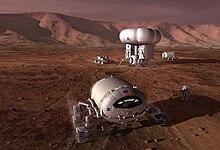
DRMA 5.0 "commuter" Mars base, Chemical Propulsion Option (2009)
NASA released an updated version of NASA DRM 5.0 in early 2009, featuring use of the
Ares V launcher,
Orion CEV, and updated mission planning. In
this document.
[61]
Extrapolated from the DRMA 5.0, plans for a manned Mars expedition with chemical propulsion.
Austere Human Missions to Mars
USA's Mars orbit by the mid-2030s (2010)
In a
major space policy speech at Kennedy Space Center on April 15, 2010, U.S. President
Barack Obama predicted a manned Mars mission to orbit the planet by the mid-2030s, followed by a landing:
By the mid-2030s, I believe we can send humans to orbit Mars and return them safely to Earth. And a landing on Mars will follow. And I expect to be around to see it.
The United States Congress has mostly approved a new direction for NASA that includes canceling Bush's planned return to the Moon by 2020 and instead proposes asteroid exploration in 2025 (
Asteroid Redirect Mission) and orbiting Mars in the 2030s.
[62]
Russian mission proposals (2011)
A number of Mars mission concepts and proposals have been put forth by
Russian scientists. Stated dates were for a launch sometime between 2016 and 2020. The Mars probe would carry a crew of four to five cosmonauts, who would spend close to two years in space.
[citation needed]
In late 2011, Russian and European space agencies successfully completed the ground-based
MARS-500.
[63] The biomedical experiment simulating manned flight to Mars was completed in Russia in July 2000.
[64]
2-4-2 concept (2011-2012)
In 2011, Jean-Marc Salotti published a new proposal for a manned Mars mission, with a release in 2012.
[65][66] The 2-4-2 concept is based on a reduction of the crew size to only 2 astronauts and the duplication of the entire mission. There are 2 astronauts in each space vehicle, there are 4 on the surface of Mars and there are 2 once again in each return vehicle. In addition, at every step of the mission, there are 2 astronauts ready to help the 2 others (2 for 2).
This architecture simplifies the entry, descent and landing procedures, which are known to be very risky, thanks to a significant reduction of the size of the landing vehicles. It also avoids the assembly of huge vehicles in LEO. The author claims that his proposal is much cheaper than the NASA reference mission without compromising the risks and can be undertaken before 2030.
NASA/SpaceX 'Red Dragon' (2012)
Red Dragon is a proposed concept for a low-cost
Mars lander mission that would use a
SpaceX Falcon Heavy launch vehicle, and a modified
Dragon capsule to
enter the
Martian atmosphere. The concept was slated to be proposed for funding in 2012/2013 as a
NASA Discovery mission, for launch in 2018.
[67][68] However, it was never proposed for that funding. The primary objective would be the search for evidence of
life on Mars (
biosignatures), past or present; a substantially unmodified version of the crewed Dragon capsule could be used for payload transport to Mars, and would be a precursor to the ambitious long-term plans of a manned mission to Mars.
[67][68]
Conceptual Space Vehicle Architecture for Human Exploration of Mars (2012)
In 2012,
Conceptual Space Vehicle Architecture for Human Exploration of Mars, with Artificial Gravity and Mini-Magnetosphere Crew Radiation Shield was released, outlaying a possible design for a human Mars mission.
[69] Components of the architecture include various spacecraft for the Earth-to-Mars journey, landing, and surface stay as well as return.
[69] Some features include a several unmanned cargo landers assembled into a base on the surface of Mars.
[69] The crew would land at this base in the "Mars Personnel Lander", which could also take them back into Mars orbit.
[69] The design for the manned interplanetary spacecraft included artificial-gravity and an artificial magnetic field.
[69] Overall, the architecture was modular and to allow for incremental R&D.
[69]
Mars One (2012)
In 2012, a
Dutch entrepreneur group revealed plans of a fund-raising campaign for a human Mars base to begin in 2023.
[70] One difference from other projects is that 'Mars One' is organized as a not-for-profit organization, strives to use worldwide suppliers, with no politics involved. It would be a "one-way" mission, i.e., there will be no return trip to Earth. Astronaut applications are invited from the public all over the world.
In 2018, a telecom orbiter would be sent, a rover in 2020, and after that the base components and its settlers.
[70] The base would be powered by 3,000 square meters of solar panels.
[71] The
SpaceX Heavy rocket would launch flight hardware.
[70] The first crew of 4 astronauts would land on Mars in 2025. Then, every two years, a new crew of 4 astronauts would arrive. Current plans specify that the entire mission is to be filmed and broadcast back to Earth as a media event, revenues from which would help fund the program.
Inspiration Mars Foundation (2013)
In 2013, the
Inspiration Mars Foundation founded by
Dennis Tito revealed plans of a manned mission to fly by Mars in 2018 with support from NASA.
[72][73]
Boeing Affordable Mission (2014)
On December 2, 2014, NASA's Advanced Human Exploration Systems and Operations Mission Director Jason Crusan and Deputy Associate Administrator for Programs James Reuthner announced tentative support for the
Boeing "Affordable Mars Mission Design" including radiation shielding, centrifugal artificial gravity, in-transit consumable resupply, and a lander which can return.
[74][75] Reuthner suggested that if adequate funding was forthcoming, the proposed mission would be expected in the early 2030s.
[76]
Current intentions
A number of nations and organisations have long-term intentions to send humans to Mars.

Planting a U.S. flag on Mars

Artist's rendering of the planned Orion/DSH/Cryogenic Propulsion Module assembly.
- The United States has a number of robotic missions currently exploring Mars, with a sample-return planned for the future. On December 5, 2014 NASA successfully launched and tested the Orion Multi-Purpose Crew Vehicle (MPCV), the first component of NASA's planned Mars mission program. The Orion MPCV will serve as the launch/ splashdown crew delivery vehicle, in combination with a Deep Space Habitat module, which will provide additional living-space for the crew on the 16-month-long journey from Earth to Mars and back. The first manned Mars Mission, which will include sending astronauts to Mars, orbiting Mars, and a return to Earth, is currently scheduled for the 2030s.[77][78][79] One possible means of propulsion for such interplanetary transport ships has been proposed by New Scientist. In its proposal, New Scientist outlines an argon plasma-based VASIMR rocket which the group claims could reduce the interplanetary transit time.[80] As a training venue for future Mars missions, NASA has used the Haughton impact crater on Devon Island due to the crater's similarity with Martian geology.[81]
- The European Space Agency has sent robotic probes, and has long-term plans to send humans but has not yet built a manned spacecraft. It plans to launch an unmanned mission to Mars, ExoMars, in 2016.
- Russia (and previously the Soviet Union) has sent a large number of probes. It can send humans into Earth orbit and has extensive experience with long-term manned orbital space flight due to its space station programs. A simulation of a manned Mars mission, called Mars-500, was completed in Russia in November 2011.
- India successfully placed an unmanned Mars Orbiter Mission (also called Mangalyaan) satellite in Mars orbit on 23 September 2014.[82]
- Japan has sent one robotic mission to Mars, the Nozomi, but it failed to achieve Mars orbit.
- China's mission to Mars, the Yinghuo-1 space probe, was lost with Russia's sample return mission to Phobos, Fobos-Grunt. China claims to have built and tested a functioning EmDrive prototype, which could reduce Mars' interplanetary transit time. The EmDrive spacecraft propulsion technology is also being investigated in the United States,[83][84] despite it being criticized as pseudoscience.[85][86][87]
Technological innovations and hurdles

Fuel is mined from Phobos with the help of a nuclear reactor.
[88]
Various technologies may aid a human mission to Mars.
One of the medical supplies that may be needed is intravenous fluid, which is mostly water but contains other things so it can be added directly to the human blood stream. If it can be created on the spot from existing water then it could spare the weight of hauling earth-produced units, whose weight is mostly water.
[89] A prototype for this capability was tested on the
International Space Station in 2010.
[89]
While it is possible for humans to breathe pure oxygen, a pure oxygen atmosphere was implicated in the
Apollo 1 fire. As such, Mars habitats may have a need for additional gases. One possibility is to take nitrogen and argon from the
atmosphere of Mars; however, they are hard to separate from each other.
[90] As a result, a Mars habitat may use 40% argon, 40% nitrogen, and 20% oxygen.
[90]
Precursor missions
Mars sample return missions

Sample return mission concept
An unmanned
Mars sample return mission (MSR) is often considered to be an essential precursor to crewed missions to Mars' surface.
Crewed orbital missions
Landis[91] and Lupisella proposed to explore Mars via
telepresence from human astronauts in orbit.
[92]
A similar idea, was the proposed "Human Exploration using Real-time Robotic Operations" (HERRO) mission.
[93][94]
Another proposed mission was the Russian
Mars Piloted Orbital Station.
Lockheed Martin as part of their "Stepping stones to Mars" project, called the "Red Rocks Project" proposed to explore Mars robotically from Deimos.
[95][96]
Mars analogs
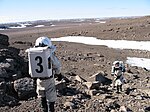
Crew for a Mars research mission practice techniques on
Devon Island, in the Canadian arctic
Mars analogs are experiments that often use environments that simulate aspects of the conditions people could experience during a hypothetical mission to Mars. These efforts have received interest by non-governmental organizations interested in spaceflight as well as notable media coverage.

